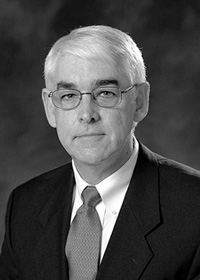Something Old, Something New: Two Problems of Confinement and Dynamics of Polymers in Solution
Lecture by Robert K. Prud'homme
Department of Chemical Engineering
Princeton University
Thursday, April 21, 2005
Room 1800 Engineering Hall
Lecture at 4:00 p.m.
Refreshments at 3:45 p.m.
We present two problems involving polymer dynamics and confinement. One is "old" — a problem of polymer flow through porous media that arises in chromatographic separations. This was one of the problems I tackled as a young faculty member at Princeton. The velocity of a polymer coil, and therefore its apparent "size," during flow through a tortuous porous media is a strong function of the Deborah number, De. We went to the simpler system of very large DNA in a 20 micron capillary to avoid the complexity of the flow field in a packed bed. Quite surprisingly, the effect of De was equally strong in this simpler flow. There was no theory that could adequately explain the results. But Ed Lightfoot had just published a paper on capillary electrophoretic separations that showed the mathematical relationship between the peak broadening and the mean velocity for any convective-flow-diffusion process. We used the theory and showed that the results were consistent with a diffusion process where the diffusivity is a function of De. Now, many years later Mike Graham and Juan de Pablo at Wisconsin have just completed beautiful simulations of DNA in small capillaries that qualitatively show the radial migration observed in our experiments. We are collaborating to close this 20 year gap in understanding flow of polymers in confined geometries. The second "new" problem involves the entry of "polymers" into small pores. But in this case the polymers are self-assembling surfactants that form "living worm-like chains." These fluids have the characteristics of classical polymer solutions that can be described by single time constant Maxwell fluids. These fluids are used in oil recovery operations involving flow into porous media because they are immune to irreversible mechanical degradation. When the confinement length scales are comparable to the length of the micelles, unexpected "filtration" phenomena are observed. The entry into the pores occurs at a critical flux, not a critical stress. The critical flux is independent of pore size over a ten-fold range of pore sizes, and is independent of bulk fluid viscosity over a hundred-fold range of viscosity. An instability occurs where the flux through the holes varies over two orders of magnitude at constant pressure. The origin of this behavior is found in a simple model by de Gennes that considers the balance of hydrodynamic drag on a "blob" of the chain entering a pore and the force associated with the confinement of the blob in the pore. This model predicts the lack of dependence on pore size, and on the bulk fluid rheology. This is the first step in the process of understanding the flow of these dynamic objects in flow through porous media.
 |
Robert K. Prud'homme is a professor in the Department of Chemical Engineering at Princeton University and the Director of the Engineering Biology Program. He received his BS at Stanford University and his PhD from the University of Wisconsin–Madison. His research interests include self-assembly of complex fluids. Systems of interest are biopolymer solutions and gels, surfactant mesophases, and polymer/surfactant mixtures, liposomes for DNA and controlled drug delivery. He has served as the undergraduate representative in the Chemical Engineering Department and on numerous departmental and university committees. He has served on the boards of directors of the American Institute of Chemical Engineers Materials Science Division, the U.S. Society of Rheology, and Dow Chemical Company's Materials Science Advisory Board. He is the recipient of an Engineering School Excellence in Teaching Award.
